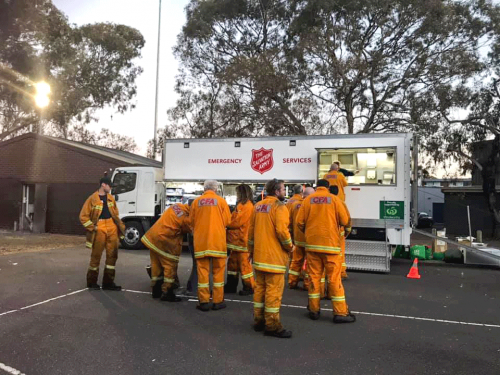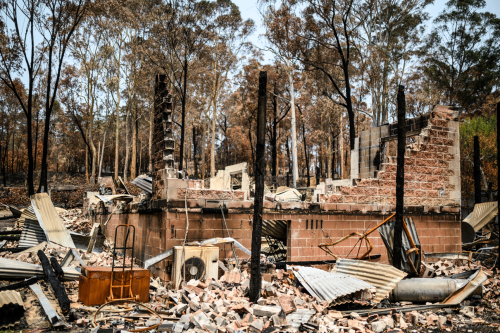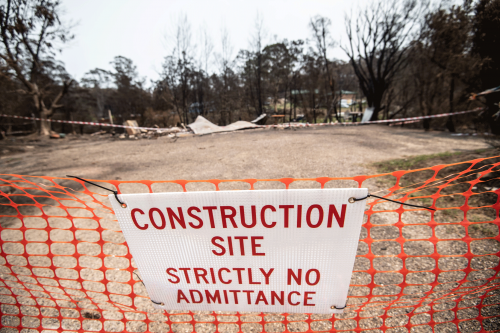Salvos join communities on the road to recovery
31 March 2020
The Salvation Army is establishing a national Bushfire Recovery Team to work at a local, collaborative level in affected areas.

Australia has been ravaged by an unprecedented bushfire crisis this summer, with many communities across the country left devastated.
The Salvation Army — as has been the case for decades — has been, along with a number of other charities, at the forefront of the emergency relief and now recovery effort.
The Australian public, corporations, Salvation Army partners and other donors have given generously in response to this disaster. When this issue of Warcry went to print on 10 February, more than $42 million in pledges had been made to The Salvation Army Disaster Appeal since its launch on 9 November 2019.
“To date, of the $42 million pledged, $18.35 million has been received,” says Lieutenant-Colonel Neil Venables, who oversees communications for The Salvation Army in Australia.
“The Salvation Army has distributed $11.9 million of this $18.35 million. Over $7.064 million has been spent towards immediate emergency and relief efforts since our Salvation Army Emergency Services (SAES) teams were activated in September 2019.
“Over $4.86 million has been distributed directly to people in terms of hardship payments — cash payments for emergencies, given through face-to-face conversations with Salvo recovery workers on the ground and the bushfire telephone line. These payments cover things such as petrol, food and emergency accommodation.
“We are confident that the balance of funds pledged will be honoured, as we have seen in the past,” Neil adds.

Colonel Winsome Merrett, Chief Secretary of operations for The Salvation Army in Australia, says money that has been raised will be spent or committed by June 2020 to the immediate and longer-term recovery of those affected by the 2019-2020 bushfires.
“The SAES teams have been active in the bushfire crisis since September 2019, with more than 3000 staff and volunteers involved,” she says. “We have provided over 240,000 meals and over 230,000 light refreshments and personal packs to first responders and evacuees.
“Our personnel and mobile units continue to remain on the ground, providing immediate financial and emotional assistance, a hand of friendship or a listening ear.
“Our staff are currently supervising a dedicated telephone line for financial assistance and have assisted thousands of people.
“We thank the Australian community for its support. Our Community Engagement and Emergency Services teams are continuing to work with federal, state and local partners in disaster response and recovery plans to map out the steps ahead.”
The Salvation Army is also establishing a nationally coordinated and locally embedded Bushfire Recovery Team. “We are involved in government forums and collaborating extensively with community groups around a response plan, which will include financial assistance; continuing to operate a dedicated telephone line where workers can assess and deliver material aid; outreach workers in local communities across Queensland, New South Wales, Victoria and South Australia; and caseworkers based in communities to deliver holistic assistance, including financial, emotional and psychological responses and financial counselling,” Neil explains.
THE ROAD AHEAD
The Salvation Army, on the back of many years’ experience in helping people recover from disasters and also in alignment with what is considered best practice in this area, has developed a three-phase approach to recovery.
“The focus of The Salvation Army’s work now is to provide support to people who have lost their properties,” says Neil. “It is anticipated that this phase will continue for at least the next 12 months, but potentially also move into a two-to-three years’ time frame.”
“The Salvation Army aims to provide a suite of support services and grants to individual households that will be tailored to their needs. These needs will be assessed and determined through the one-on-one relationship with a Salvation Army outreach recovery caseworker and the impacted household.”
This assistance may be used for needs such as:
- Temporary and transitional accommodation relocation grants
- Special housing grants (rent, power/gas, telephone/internet)
- Special household/personal grants
- Education or employment needs
- Psychological and financial counselling
- Personal needs (medical and pharmaceutical)
- Vehicle grants (registration, insurance, petrol)
- School assistance (books, uniforms, excursions)
- Family respite and recreational opportunities
- Survivor advocacy — sourcing other support networks.
The Salvation Army’s multi-stage response to the bushfires is supported by a University of Melbourne study into the Black Saturday bushfires that devastated parts of Victoria in 2009. More than 170 people died in those fires and over 2000 houses were destroyed.
The study, Beyond Bushfires, showed that, while immediate assistance during a disaster is critical, many people needed to access costly emotional and practical support at the time of rebuilding, but that support was not as easily available.
“It is critical that in our care of those impacted by these fires, The Salvation Army is responsive to these longer-term needs,” says Neil.
“The Salvation Army’s vast experience in meeting personal hardship resulting from disaster tells us that up to 70 per cent of donated funds will need to be spent in the relief and recovery stages — that is, anywhere from now up to two to three years from here.”
NATIONAL RESPONSE
In New South Wales, The Salvation Army is undertaking recovery work on the South Coast, Southern Highlands, Blue Mountains, Mid-North Coast and in northern NSW.
At Bega, in the south, Captain Deb Parsons has been distributing Salvation Army recovery funding since the centre opened a few weeks ago. She says the Army was able to assist a broad range of people, some of whom have “fallen through the cracks” due to complex circumstances.
“Some cases are not straightforward and have fallen into the ‘too-hard basket’,” she says. “That’s exactly where The Salvation Army needs to be because that’s where Jesus is always found — standing along-side those that others have passed by.”
In northern NSW and Queensland, Captains Leanne and Lincoln Stevens, Salvation Army disaster management coordinators, spent January travelling throughout the region supporting small communities impacted by drought and bushfires.
Bushfires activity has significantly decreased across Victoria, which has allowed Salvation Army staff and volunteers to support people who are reluctant to ask for help or have been overlooked.
“We’re continuing to respond to the needs of those impacted by the fires, wrapping a blanket of support around communities and picking up people who fall into the cracks,” says Captain Rob Champion, Strategic Disaster and Emergency Management Specialist with The Salvation Army.
“We need to be ready in case of evacuations, [but aside from that] we are actively engaged in recovery through the centres and outreach, and helping people as we encounter them.”
The Salvation Army has a presence in centres at Corryong, East Gippsland and Bairnsdale, where trained staff are conducting face-to-face assessments, financial assistance and emotional support. There are also recovery workers on the ground, liaising with locals and other services.
Captain Simon Mapleback has been assisting with relief efforts at Bairnsdale and has witnessed the vast emotional toll the disaster has taken on people.
“There was one gentleman, aged over 90, who shared a property with his son that was surrounded by national parks,” he shared. “They each had a home on the property and both were destroyed. Rebuilding will take from five to seven years, which was devastating news for the older man to hear, and really confronting.”
As locals come to the recovery centre with a variety of needs and responses, Simon and other staff provide them with aid, link them with other services and are simply there for them.
“One man came in recently and he was struggling to deal with what had happened. It wasn’t just the bushfires and being evacuated, but general life that was still going on with all its issues,” says Simon.
“He was almost at breaking point, working out whether he could go on. I told him the good things happening in his life. He needed to hear that.”
Referring to the collective effort as “emotional first aid”, Simon sees it as his responsibility to check on people spiritually and mentally too.
“God brings people together at the right place and the right time,” he says. “The community is being used to heal itself.”
After a mammoth bushfire season, Salvo volunteers and staff on Kangaroo Island are assessing how they can support the community with relief over the next 12 months.
The Salvation Army is expecting people affected by the fires to seek support in the coming months after the initial shock of the disaster wears off.
In Queensland, recovery relief efforts are well underway after bushfires hit several areas in late 2019.
The Salvation Army has also been involved in the emergency response and recovery effort after bushfires in Tasmania and Western Australia.

OTHER ASSISTANCE
While the bushfires have dominated the headlines in recent months, The Salvation Army continues to be involved in helping communities recover from other natural disasters.
In Townsville, long-term recovery efforts are still underway a year on from floods that inundated hundreds of homes in the North Queensland city. The Salvation Army is part of the ‘Community Rebuild Project’, a combined churches and inter-agency initiative that has identified dozens of homes whose occupiers need assistance in rebuilding.
Salvation Army rural chaplains and disaster management specialists are also active across drought-ravaged areas, providing financial and emotional assistance.
Nationally and internationally, The Salvation Army responds to natural and man-made disasters including bushfires, floods, storm damage, earthquakes, cyclones or prolonged drought. The Salvos’ response is ongoing and long-term — walking alongside those who have been impacted, with practical help, a message of hope, and caring commitment.

Comments
No comments yet - be the first.